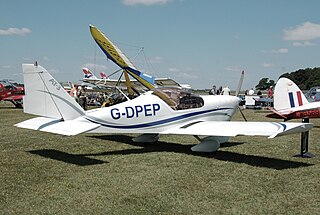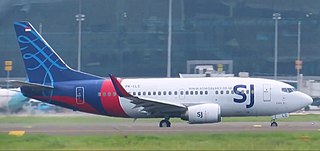Related Research Articles

Aerobatics is the practice of flying maneuvers involving aircraft attitudes that are not used in conventional passenger-carrying flights. The term is a portmanteau of "aerial" and "acrobatics". Aerobatics are performed in aeroplanes and gliders for training, recreation, entertainment, and sport. Additionally, some helicopters, such as the MBB Bo 105, are capable of limited aerobatic manoeuvres. An example of a fully aerobatic helicopter, capable of performing loops and rolls, is the Westland Lynx.

Landing is the last part of a flight, where a flying animal, aircraft, or spacecraft returns to the ground. When the flying object returns to water, the process is called alighting, although it is commonly called "landing", "touchdown" or "splashdown" as well. A normal aircraft flight would include several parts of flight including taxi, takeoff, climb, cruise, descent and landing.

In flight dynamics a spin is a special category of stall resulting in autorotation about the aircraft's longitudinal axis and a shallow, rotating, downward path approximately centred on a vertical axis. Spins can be entered intentionally or unintentionally, from any flight attitude if the aircraft has sufficient yaw while at the stall point. In a normal spin, the wing on the inside of the turn stalls while the outside wing remains flying. It is possible for both wings to stall, but the angle of attack of each wing, and consequently its lift and drag, are different.

A private pilot licence (PPL) or private pilot certificate is a type of pilot licence that allows the holder to act as pilot in command of an aircraft privately. The basic licence requirements are determined by the International Civil Aviation Organization (ICAO), but implementation varies from country to country. According to ICAO, an applicant must be at least 17 years old, demonstrate appropriate knowledge and skill, and hold at least a Class 2 medical certificate. Different PPLs are available for different categories of aircraft, such as aeroplane, helicopter, airship, etc, and are not interchangeable, although experience from a PPL in one category may be credited towards the issue of another.

The Extra Flugzeugbau EA300 is a two-seat aerobatic monoplane capable of Unlimited category competition. It was designed in 1987 by Walter Extra, a German aerobatic pilot, and built by Extra Flugzeugbau.
Pilot licencing or certification refers to permits for operating aircraft. Flight crew licences are issued by the civil aviation authority of each country, which must establish that the holder has met minimum knowledge and experience before issuing licences. The licence, along with the required class or type rating, allows a pilot to fly aircraft registered in the licence issuing state.
Pilot licensing in the United Kingdom is regulated by the Civil Aviation Authority (CAA).

Wayne Handley is an American airshow performer, former naval aviator, agricultural pilot, Aerobatic Competency Evaluator (ACE), and coach for upcoming and current airshow stars. Handley and his wife Karen are former residents of the Salinas Valley of California, who currently reside in Groveland, California.
Aircraft upset is a dangerous condition in aircraft operations in which the flight attitude or airspeed of an aircraft is outside the normal bounds of operation for which it is designed. This may result in the loss of control (LOC) of the aircraft, and sometimes the total loss of the aircraft itself. Loss of control may be due to excessive altitude for the airplane's weight, turbulent weather, pilot disorientation, or a system failure.

The Slingsby T67 Firefly, originally produced as the Fournier RF-6, is a two-seat aerobatic training aircraft, built by Slingsby Aviation in Kirkbymoorside, Yorkshire, England.

EASA CS-VLA is the European Aviation Safety Agency Certification Specification for Very Light Aircraft.

A type rating is an authorization entered on or associated with a pilot license and forming part thereof, stating the pilot's privileges or limitations pertaining to certain aircraft type. Such qualification requires additional training beyond the scope of the initial license and aircraft class training.

FedEx Express Flight 14 was a scheduled cargo flight from Singapore to Newark, New Jersey, via Malaysia, Taiwan, and Alaska. On July 31, 1997, the aircraft flying this route crashed during landing on its final segment at Newark International Airport (EWR), inverting and catching fire, injuring all five people on board.
Supermaneuverability is the capability of fighter aircraft to execute tactical maneuvers that are not possible with purely aerodynamic techniques. Such maneuvers can involve controlled side-slipping or angles of attack beyond maximum lift.

In aviation, a class rating is an allowance to fly a certain group of aircraft that require training common to all aircraft within the group. A type rating is specified if a particular aircraft requires additional specialized training beyond the scope of initial license and aircraft class training. Which aircraft require a type rating is decided by the local aviation authority. Almost all single-engine piston (SEP) or multi-engine piston (MEP) single pilot aircraft can be flown without a type rating, but are covered by a class rating instead.
The light aircraft pilot licence (LAPL) is a pilot license allowing the pilot to fly small aircraft. It is issued in EASA member states and the United Kingdom. Unlike most other licences, it is not covered by the ICAO framework and is usually not able to be used in other states or regulatory areas.
Aviation Performance Solutions is an aviation training company based in Mesa, Arizona. APS trains and instructs pilots of all experience levels in Upset Prevention and Recovery Training (UPRT).

Sriwijaya Air Flight 182 was a scheduled domestic passenger flight from Jakarta to Pontianak, Indonesia. Five minutes after departing from Soekarno–Hatta International Airport on 9 January 2021, the Boeing 737-500 experienced an upset and crashed into the Java Sea off the Thousand Islands, killing all 62 people on board. A search of the area recovered wreckage, human remains, and items of clothing. The flight data recorder (FDR) was recovered on 12 January, and the data storage module of the cockpit voice recorder was recovered on 30 March.
Aviation in the European Union and the European Free Trade Association is regulated by the European Union Aviation Safety Agency (EASA). EASA specifies common standards for the licensing of aircraft pilots. EASA does not issue licences, rather licences are issued by member states. However, because the same standards are used, EASA licences are recognised by all member states.
A multi-crew pilot licence (MPL) is a pilot licence that permits an aircraft pilot to act as co-pilot of a multi-crew aircraft.
References
- 1 2 "Upset Prevention and Recovery Training". EASA. Retrieved 17 February 2022.
- 1 2 "Advisory Circular 120-111: Upset Prevention and Recovery Training" (PDF). Federal Aviation Authority. Retrieved 18 February 2022.
- ↑ "UPRT | UPRT Programmes in the UK | Ultimate High". uprt. Retrieved 17 February 2022.
- ↑ "Manual on Aeroplane Upset Prevention and Recovery Training, 2014" (PDF). ICAO. Retrieved 17 February 2022.
- ↑ "UPRT worldwide rules and guidance" (PDF). ICAO. Retrieved 17 February 2022.
- ↑ Knowles, Ian. "Upset Prevention and Recovery Training Workshop" (PDF). ICAO. Retrieved 18 February 2022.
- ↑ "Guidance Material and Best Practices for the Implementation of Upset Prevention and Recovery Training, 2nd edition" (PDF). IATA. Retrieved 17 February 2022.
- ↑ Badick, Joseph R.; Johnson, Brian A. (9 November 2021). Flight Theory and Aerodynamics: A Practical Guide for Operational Safety. John Wiley & Sons. p. 303. ISBN 978-1-119-77239-2.
- 1 2 Koglbauer, Ioana V; Biede-Straussberger, Sonja (15 July 2021). Aviation Psychology: Applied Methods and Techniques. hogrefe Publishing. ISBN 978-1-61334-588-7 . Retrieved 17 February 2022.
- ↑ "TrainingCom, Spring 2020" (PDF). UK CAA. Retrieved 17 February 2022.